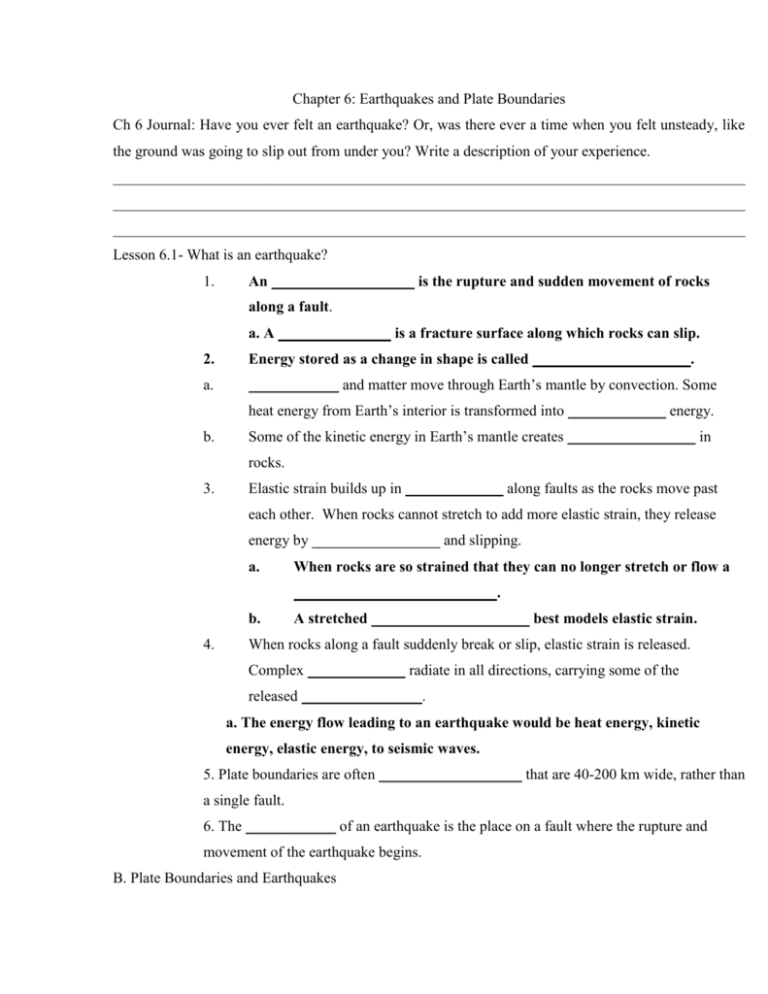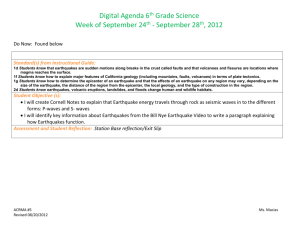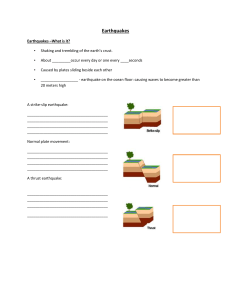Chapter 6: Earthquakes and Plate Boundaries Ch 6 Journal: Have
advertisement

Chapter 6: Earthquakes and Plate Boundaries Ch 6 Journal: Have you ever felt an earthquake? Or, was there ever a time when you felt unsteady, like the ground was going to slip out from under you? Write a description of your experience. ____________________________________________________________________________________ ____________________________________________________________________________________ ____________________________________________________________________________________ Lesson 6.1- What is an earthquake? 1. An ___________________ is the rupture and sudden movement of rocks along a fault. a. A _______________ is a fracture surface along which rocks can slip. 2. Energy stored as a change in shape is called _____________________. a. ____________ and matter move through Earth’s mantle by convection. Some heat energy from Earth’s interior is transformed into _____________ energy. b. Some of the kinetic energy in Earth’s mantle creates _________________ in rocks. 3. Elastic strain builds up in _____________ along faults as the rocks move past each other. When rocks cannot stretch to add more elastic strain, they release energy by _________________ and slipping. a. When rocks are so strained that they can no longer stretch or flow a ___________________________. b. 4. A stretched _____________________ best models elastic strain. When rocks along a fault suddenly break or slip, elastic strain is released. Complex _____________ radiate in all directions, carrying some of the released ________________. a. The energy flow leading to an earthquake would be heat energy, kinetic energy, elastic energy, to seismic waves. 5. Plate boundaries are often ___________________ that are 40-200 km wide, rather than a single fault. 6. The ____________ of an earthquake is the place on a fault where the rupture and movement of the earthquake begins. B. Plate Boundaries and Earthquakes 1. Most, but not all, earthquakes occur at _____________________. The three different types of plate boundaries have different usual patterns of ___________________. a. Most earthquakes at __________________________________ occur at relatively shallow depths and are relatively weak earthquakes. b. At transform plate boundaries, most earthquakes occur on ______________ faults and at relatively _________________ depths. Earthquakes with a shallow focus can produce severe shaking, and so dangerous earthquakes can occur at transform plate boundaries. c. Earthquakes at convergent plate boundaries tend to be the ______________ earthquakes. They have been some of the most destructive earthquakes in human history. 2. A ______________ percentage of earthquakes occur away from plate boundaries. These earthquakes can be destructive because people are often unprepared for them. Lesson 6.2- Earthquakes and Seismic Waves A. What are seismic waves? 1. _____________________ are waves of energy produced at the focus of an earthquake as elastic strain is released. a. Seismic waves travel ______________ in all directions from the _________ of an earthquake. b. The amount of energy carried by seismic waves ______________ as the waves move away from the focus. This is because rocks _______________ some energy as the seismic waves pass through them. 2. The _________________ of an earthquake is the point on Earth’s surface directly above the focus of the earthquake. B. Types of Seismic Waves 1. There are _____________ different types of seismic waves: primary waves, secondary waves, and surface waves. a. ______________________ are compressional waves that move rocks and other matter parallel to the direction the wave is traveling. Primary waves are the fastest seismic waves. b. _______________________ are ___________ waves that move rocks and other matter back and forth perpendicular to the direction the waves are traveling. Secondary waves travel about 60 percent as fast as P-waves. c. A _______________ illustrates the motion of an S-wave. d. Some of the energy from P-waves and S-waves that reach Earth’s surface can be trapped in the upper areas of Earth’s crust to form surface waves. Surface waves are the _________________ type of seismic wave. e. Surface waves usually cause _________________ shaking than P-waves or S-waves, and they are often the most destructive type of seismic wave. C. Using Seismic Wave Data 1. A __________________ is a scientist who studies earthquakes. 2. The ________________ you are from the focus of an earthquake, the farther S- waves will be behind the P- waves. 3. Seismic waves change speed and ___________________ when the material through which they are traveling changes. 4. Observing the paths of seismic waves can help scientists to understand what kind of ____________ make up Earth’s interior. 5. The __________________ is a portion of Earth that does not receive any seismic waves from a particular earthquake. 6. Because S-waves cannot move through ______________ and P-waves would be bent by a _________, scientists think Earth’s outer core is liquid and causes the ______________________. 7. If a seismograph is located a great distance from the epicenter, the P-waves would arrive _____________ than the S-waves. Lesson 6.3- Measuring Earthquakes A. How are Earthquakes measured? 1. Scientists determine the size of the large earthquake that occurred in the _____________ Ocean on December 26, 2004, by measuring how much the rock moved along the __________ where the earthquake started. 2. Because the earthquake occurred ___________________, the movement of rock caused a huge ocean _____________ in the Indian Ocean. B. Recording Seismic Waves 1. A _______________________ is an instrument used to record and measure movements of the ground caused by seismic waves. It measures the ________________ of an earthquake. a. Seismographs record the size, direction, and time of the movements caused by different types of ________________________. b. Seismographs record ground motion in two orientations: _______________, or backand-forth, and ___________________, or up-and-down. 2. The record of the seismic waves created by a seismograph is called a ______________________. a. The x-axis of a seismogram represents ______________. b. Heights of waves on a seismogram show the relative size of ground ______________ caused by seismic waves. c. ___________________ are the type of seismic wave that is recorded first on a seismograph. C. Locating an Epicenter 1. With readings from at least _____________ seismographs, you can use triangulation to find the location of the _________________ of an earthquake. a. Use a seismogram to measure the number of _________________ between the arrival of P-waves and the arrival of S-waves. b. Use a graph showing the _____________________ between P- and S-waves plotted against distance to determine how far the waves traveled. c. On a map, draw a _________________ with a radius equal to the distance the waves have traveled around the location of the seismograph. d. Draw the same kind of circles for additional seismograms. The location of the ____________________ will be shown by the intersection of the circles. D. Measuring Earthquake Size 1. The ____________________ scale is based on a seismogram’s record of the amplitude of ground motion. a. Numerical measurements of magnitude vary from about 0.0 to 9.0, but each one number represents ___________ times the amount of ground motion. b. Magnitude can also be used to understand the amount of _______________ released by an earthquake. An increase of ___________ unit on the magnitude scale represents 30 times as much energy being released. 2. The ______________________________ scale was the first magnitude scale, but is not as accurate as more modern magnitude scales. With the Richter scale, the magnitude values are not accurate for __________________ earthquakes. 3. Today, the most commonly used scale for measuring earthquakes is the __________________________ scale. E. Earthquake Intensity 1. Besides size, earthquakes can also be compared by their _____________, or the amount of damage they cause. 2. Intensity tends to ________________ as you move from the epicenter, but it can vary depending on the types of rocks or sediments in an area. 3. The most widely used intensity scale in the U.S. is the __________________________ scale. Lesson 6.4- Earthquake Hazards and Safety A. Earthquake Hazards 1. Most injuries from an ___________________ are caused by the collapse of buildings and other structures, not directly by the ground shaking. 2. Fires caused by broken ____________________ or electrical lines are the most common hazard following an earthquake. 3. A ___________________ is the sudden movement of soil and rocks down a slope. 4. Earthquakes sometimes cause _________________, a process by which shaking makes loose sediment behave like a liquid. Liquefaction near buildings can cause them to _______________ into the ground. 5. An ocean wave caused by an earthquake is called a _________________ wave, or a ____________________. a. Like seismic waves, tsunamis carry energy, but they can also cause flooding and carry objects in the _________________ they move. b. The towering wave on a tsunami forms where the wave hits ______________ water. c. A warning sign just before a tsunami strikes, water along a _______________________ sometimes moves quickly toward the sea, exposing areas that are usually underwater. B. Avoiding Earthquake Hazards 1. The chance of earthquake damage is greatest close to ______________ and also increases in areas where Earth’s surface is made of ______________ sediments rather than solid rocks. 2. ______________ showing where the chance of earthquake damage is greatest, such as in areas along the San Andreas Fault, can help in the planning of safe ways to use land. C. Earthquakes and Structures 1. Tall buildings or structures and buildings made of ______________ materials usually suffer the most damage in an earthquake. Structures made from flexible building materials, such as __________, usually suffer less damage. 2. Some buildings in areas threatened by earthquakes are supported by ______________, circular moorings placed under the buildings. These moorings act like shock absorbers for the buildings. D. Earthquake Safety 1. To be as safe as possible during and after an earthquake, it is important to prepare _________________ of time. a. With your family, ______________, review, and practice an earthquake disaster plan. b. Make an earthquake supply kit with canned food, water, a battery-powered _______________, a flashlight, and first aid supplies. c. Move _________________ objects close to the ground, and learn how to shut off gas, water, and __________________ in your home. 2. During an _______________________, stay indoors, get away from anything that could break or fall on you, and find something sturdy to hide underneath.








